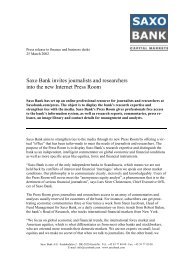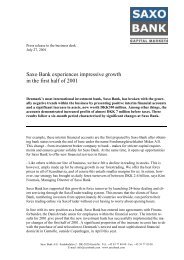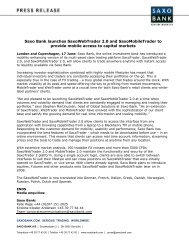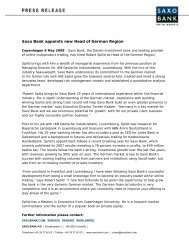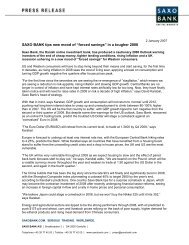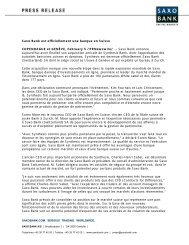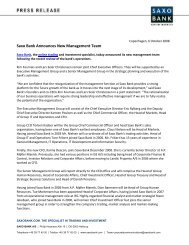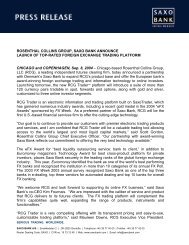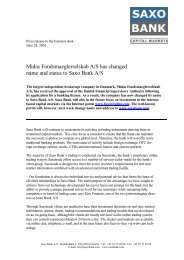Untitled - Saxo World
Untitled - Saxo World
Untitled - Saxo World
Create successful ePaper yourself
Turn your PDF publications into a flip-book with our unique Google optimized e-Paper software.
NOTES – saxo bank risk managementSettlement riskSettlement risk is the risk that <strong>Saxo</strong> Bank delivers one legof a transaction but the counterparty fails to meet its obligation.<strong>Saxo</strong> Bank has entered into settlement agreementsto decrease settlement risk on foreign exchange.This includes give-up agreements to the Bank’s prime brokers(PB) and continuous linked settlements (CLS). Evenso, the Bank occasionally endures settlement risk whentrades are not matched in CLS but have to be gross settledagainst a given counterpart.The above mentioned credit related risks are managed onan ongoing basis by risk policies, systems and proceduresapproved by the Board of Management.Operational RiskOperational risk is defined as the risk of loss resultingfrom inadequate or failed processes, people and systemsfrom internal and external events.The Bank evaluates its exposure and establishes processesfor managing operational risk. This includes an evaluationof rare events that could cause significant loss, a so-calledBlack Swan.<strong>Saxo</strong> Bank’s operational risk management framework consistsof seven key components: Risk identification, Riskanalysis, Risk evaluation, Risk responses, Monitor, report &review, Organisation and Policies.Risk IdentificationThe aim of risk identification is to identify the Bank’spotential risk exposures. This includes:• Risk collection: Ensures that potential risk events aregathered within the company• Risk categorisation: Ensures that risk events are classifiedunder required categories• Risk assessment: Evaluates risks in terms of likelihoodand impactRisk events are gathered through interviews and input fromexternal experts, and thereafter documented and maintainedin the Bank’s risk register. This risk register contains,amongst other things, the expected likelihood, expec tedimpact and extreme case impact of each identified riskevent.Risk AnalysisThe content of the risk register is analysed through analyticalapproaches including scenario analysis and MonteCarlo simulations. The latter method is used to generaterandom loss scenarios based on assessed probabilities andimpact. The result is a loss distribution, which forms thebasis for the determination of expected loss, Value-at-Riskand expected shortfall with one year horizon. Assumptionsare made on confidence levels as well as on the correlationbetween the various events.Risk EvaluationThe outcome of the risk analysis is discussed in workshopswith various stakeholders within the Bank. The aim of theworkshops is to validate and challenge the results. Thestakeholders have an opportunity to question, accept orreject the results. If a stakeholder questions the results,further investigation or revision of the applied methodologyis carried out. Furthermore, the stakeholders have theopportunity to challenge the validity and relevance of theappropriate stress scenarios and propose new scenarios.Risk ResponsesTo address risks each material risk is assigned to an appropriateentity within the Bank. The response to a risk isbased on the criticality and cause identified during the riskidentification process. In general, risks are• Eliminated• Mitigated• Transferred• RetainedIn some cases, combined actions are taken to address anissue. For example, the residual risk after implementing acontrol can be covered by insurance.Monitor, Report and ReviewThe monitoring process assists in the early detection andcorrection of errors and the prevention of or reduction in70 · SAXO BANK · ANNUAL REPORT 2009



